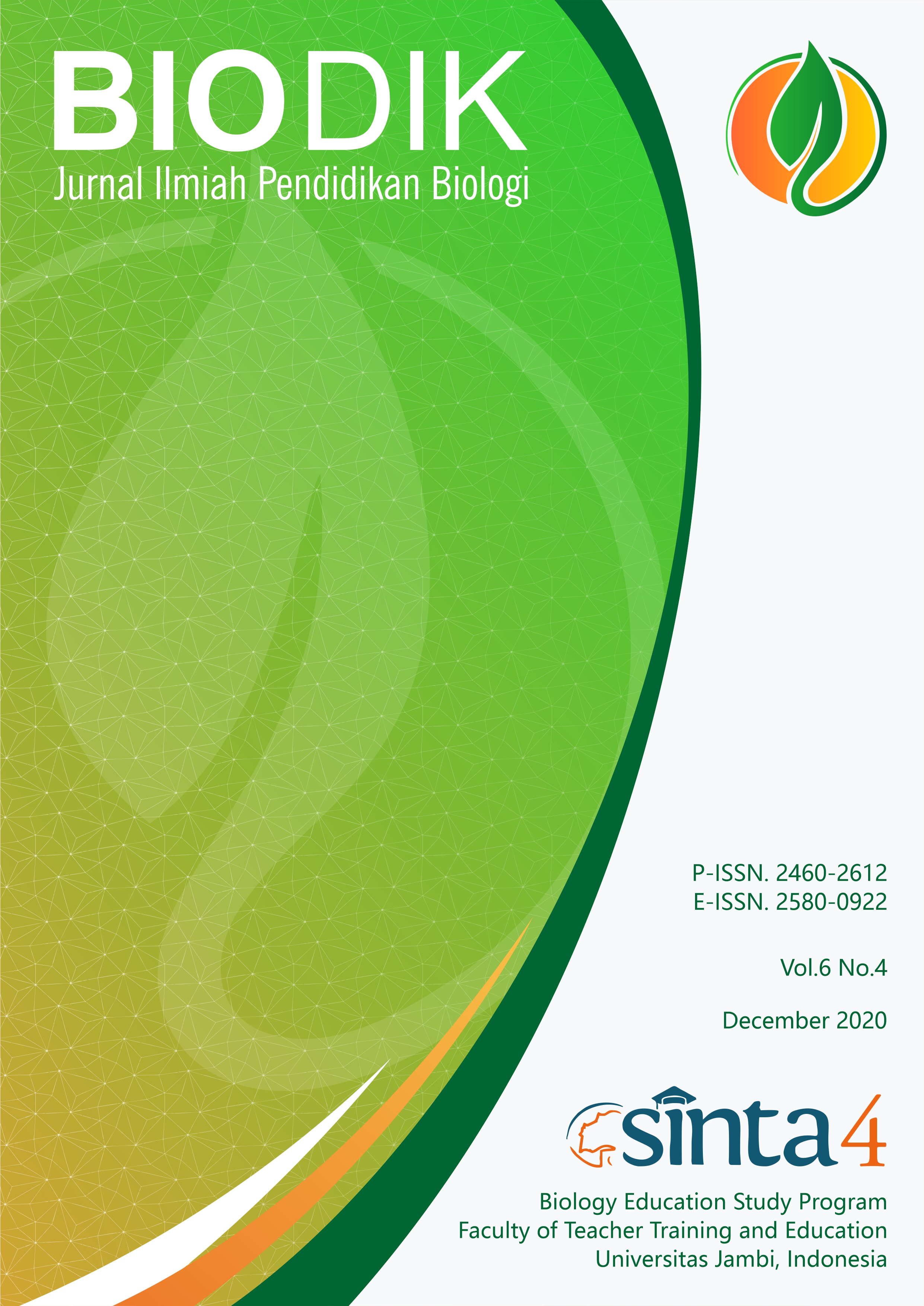Analisis Kualitas Struktur Lembar Kerja Peserta Didik pada Materi Struktur Tulang Berbasis Diagram Vee
(An Analysis of the Quality of Bone Structure Student Worksheets Based on the Vee Diagram)
DOI:
https://doi.org/10.22437/bio.v6i4.9500Abstract
Student worksheets used as practical guide in laboratory activities will highly determine the achievement of learning objectives required by the curriculum. However, the structure of student worksheet as a laboratory activity design still should be improved. This study aims to explain the results of the analysis of bone structure student worksheets used in learning with National Curriculum 2006 and 2013. The research method used was qualitative descriptive method and the sample were 6 student worksheets. The student worksheets were used as practical guide in laboratory activities in national senior high school in Garut Regency and selected using a total sampling technique. The research instruments used were completeness of the student worksheets components rubric and scoring rubric of the components of Vee Diagram adapted from Novak & Gowin (1984). The results showed that the bone structure student worksheets used in national senior high school in Garut Regency still have incomplete Vee Diagram components and the components appear still do not have a maximum score.
Abstrak. Lembar Kerja Peserta Didik (LKPD) yang digunakan sebagai panduan kegiatan laboratorium akan menentukan ketercapaian tujuan kegiatan laboratorium dan tujuan pembelajaran yang dituntut oleh kurikulum. Namun, struktur LKPD yang memuat desain kegiatan laboratorium sekolah nyatanya masih jauh dari yang diharapkan. Penelitian ini bertujuan untuk menjelaskan tentang hasil analisis terhadap LKPD Struktur Tulang yang digunakan pada saat pembelajaran dengan Kurikulum Tingkat Satuan Pendidikan (KTSP) 2006 dan Kurikulum 2013. Metode penelitian yang digunakan adalah metode deskriptif kualitatif dengan sampel penelitian berjumlah 6 LKPD. Sampel LKPD tersebut digunakan sebagai petunjuk kegiatan laboratorium di SMA Negeri di Kabupaten Garut dan dipilih dengan menggunakan teknik total sampling. Instrumen penelitian yang digunakan untuk menilai kualitas struktur LKPD adalah rubrik kelengkapan komponen LKPD dan rubrik penskoran komponen LKPD berdasarkan Diagram Vee yang diadaptasi dari Novak & Gowin (1984). Hasil penelitian menunjukkan bahwa LKPD Struktur Tulang yang digunakan di SMA Negeri di Kabupaten Garut belum memiliki komponen Diagram Vee lengkap dan komponen-komponen yang ada belum mencapai skor maksimum.
Downloads
References
Calais, G. J. (2009). The Vee Diagram as a Problem Solving Strategy: Content Area Reading/Writing Implications. National Forum Teacher Education Journal, 19(3), 1–8.
Festile, R. M. (2017). The Influence of Practical Work in the Teaching and Learning of Acids, Bases, and Neutrals in Natural Sciences [University of the Western Cape]. http://hdl.handle.net/11394/5921
Koirala, K. P. (2019). Effectiveness of Practical Work on Students’ Achievement in Science at Secondary Level in Gorkha District Nepal. Journal of Advances in Education Research, 4(4), 139–147. https://doi.org/10.22606/jaer.2019.44001
Millar, R. (2001). Teaching and Learning Science Through Practical Work.
Millar, R. (2004). The Role of Practical Work in The Teaching and Learning of Science.
Millar, R., & Abrahams, I. (2009). Practical Work: Making It More Effective. School Science Review, 91(334), 59–64.
Nadia, Supriatno, B., & Anggraeni, S. (2020). Analisis dan Rekonstruksi Komponen Penyusun Lembar Kerja Peserta Didik Struktur dan Fungsi Jaringan Tumbuhan. BIODIK: Jurnal Ilmiah Pendidikan Biologi, 6(2), 187–199.
Novak, J. D., & Gowin, D. B. (1984). Learning How to Learn. Cambridge University.
Ramadhayanti, Anggraeni, S., & Supriatno, B. (2020). Analisis dan Rekonstruksi Lembar Kerja Peserta Didik Indra Pengecap Berbasis Diagram Vee. BIODIK: Jurnal Ilmiah Pendidikan Biologi, 6(200–213).
Rustaman, N. (2005). Strategi Belajar Mengajar Biologi. Universitas Negeri Malang.
Society of Biology. (2010). The Importance of Practical Biology: from School to Higher Education.
Sugiyono. (2012). Memahami Penelitian Kuantitatif, Kualitatif, dan R&D. Alfabeta.
Supriatno, B. (2013). Pengembangan Program Perkuliahan Pengembangan Praktikum Biologi Sekolah Berbasis ANCORB untuk Mengembangkan Kemampuan Merancang dan Mengembangkan Desain Kegiatan Laboratorium. http://repository.upi.edu/id/eprint/3661
Supriatno, B. (2009). Uji Langkah Kerja Laboratorium Sekolah. Proseding Seminar Nasional Biologi: Inovasi Dan Pendidikan Biologi Dalam Pengembangan Sumber Daya Manusia, 255–261.
Wahidah, N. S., Supriatno, B., & Kusumastuti, M. N. (2018). Analisis Struktur dan Kemunculan Tingkat Kognitif pada Desain Kegiatan Laboratorium Materi Fotosintesis. Assimilation: Indonesian Journal of Biology Education, 1(2), 70–76. https://doi.org/https://doi.org/10.17509/aijbe.v1i2.13050
Downloads
Published
Versions
- 2020-12-17 (2)
- 2020-12-17 (1)
How to Cite
Issue
Section
License
Copyright (c) 2020 Resta Istawa, Bambang Supriatno, Sri Anggraeni

This work is licensed under a Creative Commons Attribution-NonCommercial-ShareAlike 4.0 International License.
Copyright Notice
Authors who publish with Biodik : Jurnal Ilmiah Pendidikan Biologi agree to the following terms:
- For all articles published in Biodik : Jurnal Ilmiah Pendidikan Biologi, copyright is retained by the authors and grant the journal right of first publication with the work simultaneously licensed under a Creative Commons Attribution-ShareAlike 4.0 International Licensethat allows others to share the work with an acknowledgment of the work's authorship and initial publication in this journal.
- Authors are able to enter into separate, additional contractual arrangements for the non-exclusive distribution of the journal's published version of the work (e.g., post it to an institutional repository or publish it in a book), with an acknowledgment of its initial publication in this journal.
- Authors are permitted and encouraged to post their work online (e.g., in institutional repositories or on their website) prior to and during the submission process, as it can lead to productive exchanges, as well as earlier and greater citation of published work (See The Effect of Open Access).
















